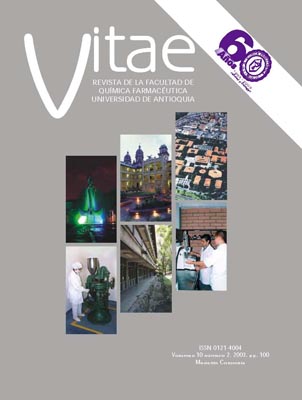Nuevos procesos de biodegradación de colorantes, utilizando hongos de la podredumbre blanca de la madera
DOI:
https://doi.org/10.17533/udea.vitae.437Keywords:
hongos de la pobredumbre blanca de la madera, degradaciòn de colorantes, enzimas, lacasa, manganesoo, peroxidasa, white rot fungi, dyes degradation, enzyme, laccase, manganese-peroxidaseAbstract
Los colorantes sintéticos son extensamente utilizados en la elaboración de productos farmaceúticos, cosméticos, alimentos, y en muchos otros sectores manufactureros. Durante los procesos de producción y de coloración, de 10 a 15% de los colorantes utilizados, son vertidos en los afluentes como desechos contaminantes, los cuales tienen gran persistencia, son tóxicos y por tanto deben ser degradados o al menos totalmente neutralizados antes de ir al ambiente. Los hongos que causan podredumbre blanca de la madera han demostrado su capacidad para degradar colorantes. En este trabajo estudian 57 cepas de hongos de la colección que existe en la Universidad Católica de Lovaina y el Instituto de Higiene de Varsovia (Polonia) - mediante el ensayo de decoloración en microplacas-. Se seleccionan 17 hongos que muestran decoloración o cambio de color de dos colorantes, uno azoico y otro antraquinónico. Con ellos se hacen estudios de las condiciones fisiológicas: fuentes de carbono y nitrógeno, temperatura, agitación, formas de crecimiento libre o inmovilizadas y condiciones que favorecen la expresión de las enzimas manganeso peroxidasa - MnP- y la lacasa, que han sido identificadas como responsables de la degradación de los colorantes. En este trabajo se presentan además los resultados de 5 cepas seleccionadas sobre aguas con residuos del colorante azul índigo, obteniéndose una disminución del color del 95.3% al quinto día, en todas las muestras evaluadas.
Downloads
Downloads
Published
How to Cite
Issue
Section
License
Copyright Notice and Open Access Statement
The Journal Vitae works under the Open Access license, and the published manuscripts remain available for the public, both on the Journal's website and in databases, under the Creative Commons license, "Noncommercial Attribution" and "Share alike" systems, adopted in Colombia. Hence, when the authors agree to publish in the Journal Vitae, they will not have the right to economic retributions on publications and reproductions through different diffusion media. The documents are freely available to the internet public, permitting users to read, download, copy, distribute, print, search, or link to the full texts and pass them as data to software. The only constraint on reproduction and distribution, should be to give authors control over the integrity of their work and the right to be appropriately acknowledged and cited.
Authors declare that:
-
They are the intellectual property owners and are responsible for all the information stated in the article.
-
This manuscript has not been submitted or published in other printed or digital media. They accept the responsibility for the judgments, opinions, and points of view expressed in the published article and, therefore, they exonerate Universidad de Antioquia and Journal Vitae from any process.
-
They exempt Universidad de Antioquia and Journal Vitae from settling conflicts or disputes related to the authorship of the referred article.
-
They accept the revision of the original manuscript by suitable personnel, and they bind themselves to perform the corrections appointed or suggested by the assessors.
-
Therefore, they know the editorial process and will not bind the Editorial Board of the Journal to assume any obligations regarding the volume and issue in which the article is published.
-
They transfer the rights of publication, reprinting, and distribution of the article from the moment of its approval, in print and digital format, without the right to economic rewards, and under the licensing conditions considered relevant by Journal Vitae.
-
They fully authorize Universidad de Antioquia and Journal Vitae to submit the published material to the diverse databases and indexing systems where the Journal can be found to comply with the requirements of the regulatory authorities to maintain the national classification of journals.
-
They will assume the article publication costs established for the current issue, and they will make the payment as soon as they are informed about the volume and the issue in which the final version of the article is published.
-
After the article is published, you can share digital or printed copies in a noncommercial manner. You will be able to use the paper in your institution or company for educational or research purposes, including the use in course programs.
Conflict of interest: Authors are responsible for recognizing and disclosing any financial or other benefits that could be perceived to bias their work, acknowledging all financial support and any personal connections with potential sponsors. Examples of such conflicts include receiving research funds or honoraria, serving on advisory boards, stock ownership, or employment and consulting arrangements. Authors without such connections should clearly state that they have no financial support or personal relationships that could be perceived to bias their work. All conflicts of interest should be disclosed on the author's identification page of the manuscript.










